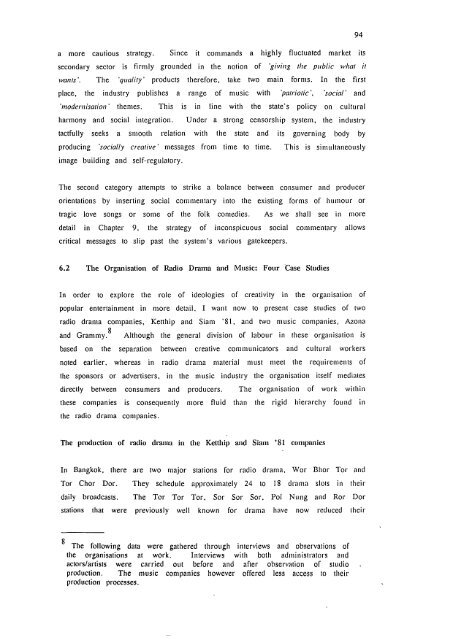iieiiei1eWrkers - Leicester Research Archive - University of Leicester
iieiiei1eWrkers - Leicester Research Archive - University of Leicester
iieiiei1eWrkers - Leicester Research Archive - University of Leicester
Create successful ePaper yourself
Turn your PDF publications into a flip-book with our unique Google optimized e-Paper software.
a more cautious strategy. Since it commands a highly fluctuated market its<br />
secondary sector is firmly grounded in the notion <strong>of</strong> 'giving the public what it<br />
warns'. The 'quality' products therefore, take two main forms. In the first<br />
place, the industry publishes a range <strong>of</strong> music with 'pa/rio/ic', 'social' and<br />
'modern isation' themes. This is in line with the state's policy on cultural<br />
harmony and social integration. Under a strong censorship system, the industry<br />
tactfully seeks a smooth relation with the state and its governing body by<br />
producing 'socially creative ' messages from time to time. This is simultaneously<br />
image building and self-regulatory.<br />
The second category attempts to strike a balance between consumer and producer<br />
orientations by inserting social commentary into the existing forms <strong>of</strong> humour or<br />
tragic love songs or some <strong>of</strong> the folk comedies. As we shall see in more<br />
detail in Chapter 9, the strategy <strong>of</strong> inconspicuous social commentary allows<br />
critical messages to slip past the system's various gatekeepers.<br />
6.2 The Organisation <strong>of</strong> Radio Drama and Music: Four Case Studies<br />
In order to explore the role <strong>of</strong> ideologies <strong>of</strong> creativity in the organisation <strong>of</strong><br />
popular entertainment in more detail, I want now to present case studies <strong>of</strong> two<br />
radio drama companies, Ketthip and Siam '81, and two music companies, Azona<br />
and Grammy. 8 Although the general division <strong>of</strong> labour in these organisation is<br />
based on the separation between creative communicators and cultural workers<br />
noted earlier, whereas in radio drama material must meet the requirements <strong>of</strong><br />
the sponsors or advertisers, in the music industry the organisation itself mediates<br />
directly between consumers and producers. The organisation <strong>of</strong> work within<br />
these companies is consequently more fluid than the rigid hierarchy found in<br />
the radio drama companies.<br />
The production <strong>of</strong> radio drama in the Ketthip and Siam '81 companies<br />
In Bangkok, there are two major stations for radio drama. Wor Bhor Tor and<br />
Tor Chor Dor. They schedule approximately 24 to 18 drama slots in their<br />
daily broadcasts. The Tor Tor Tor, Sor Sor Sor. Pol Nung and Ror Dor<br />
stations that were previously well known for drama have now reduced their<br />
8 The following data were gathered through interviews and observations <strong>of</strong><br />
the organisations at work, Interviews with both administrators and<br />
actors/artists were carried out before and after observation <strong>of</strong> studio<br />
production. The music companies however <strong>of</strong>fered less access to their<br />
production processes.<br />
94














